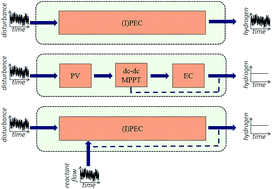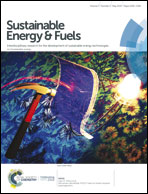Controlling strategies to maximize reliability of integrated photo-electrochemical devices exposed to realistic disturbances†
Abstract
We numerically investigate the conversion of solar energy into chemical energy by integrated photo-electrochemical (IPEC) devices and assess their response to time-dependent changes in the boundary conditions and the material properties. We focus on a device architecture which uses concentrated solar irradiation to reduce the use of rare and expensive components such as light absorbers and catalysts. For practical usability of IPEC devices, it is of particular importance that the device operates with stable efficiency and production rates. Variations in the operating conditions, resulting, for example, from degradation of the materials over the lifetime and from the daily and seasonal changes in incoming irradiation, pose a challenge for the stable and secure production of fuel from such devices. To tackle these issues, we develop performance optimization strategies utilizing device design, component and material choice, and adaptation of operational conditions. Degradation effects can be alleviated (3–21% improvement in production) by dynamically adapting the input water flow rates. The water mass flow controller acts as an optimum operating point tracker for the IPEC device eliminating any need for additional, external power electronics (such as a dc–dc based maximum power point tracker). Mass flow rate adaptation can further be used to alleviate higher frequency variations given by the per-minute and daily variation in the irradiation. A stabilized efficiency and hydrogen production for the day can be achieved with mass flow controlling, with a production increase in the range of 1–6%. The developed strategies highlight that the design of an IPEC device needs to consider the realistic operation of the IPEC during the complete life. The developed strategies show that mass flow control allows for a more dynamic PEC operation and is a powerful tool to ensure robust and efficient device operation and to allow for alleviation of degradation effected performance reduction while excluding any external power electronics.

- This article is part of the themed collection: 3rd International Solar Fuels Conference and International Conference on Artificial Photosynthesis


 Please wait while we load your content...
Please wait while we load your content...